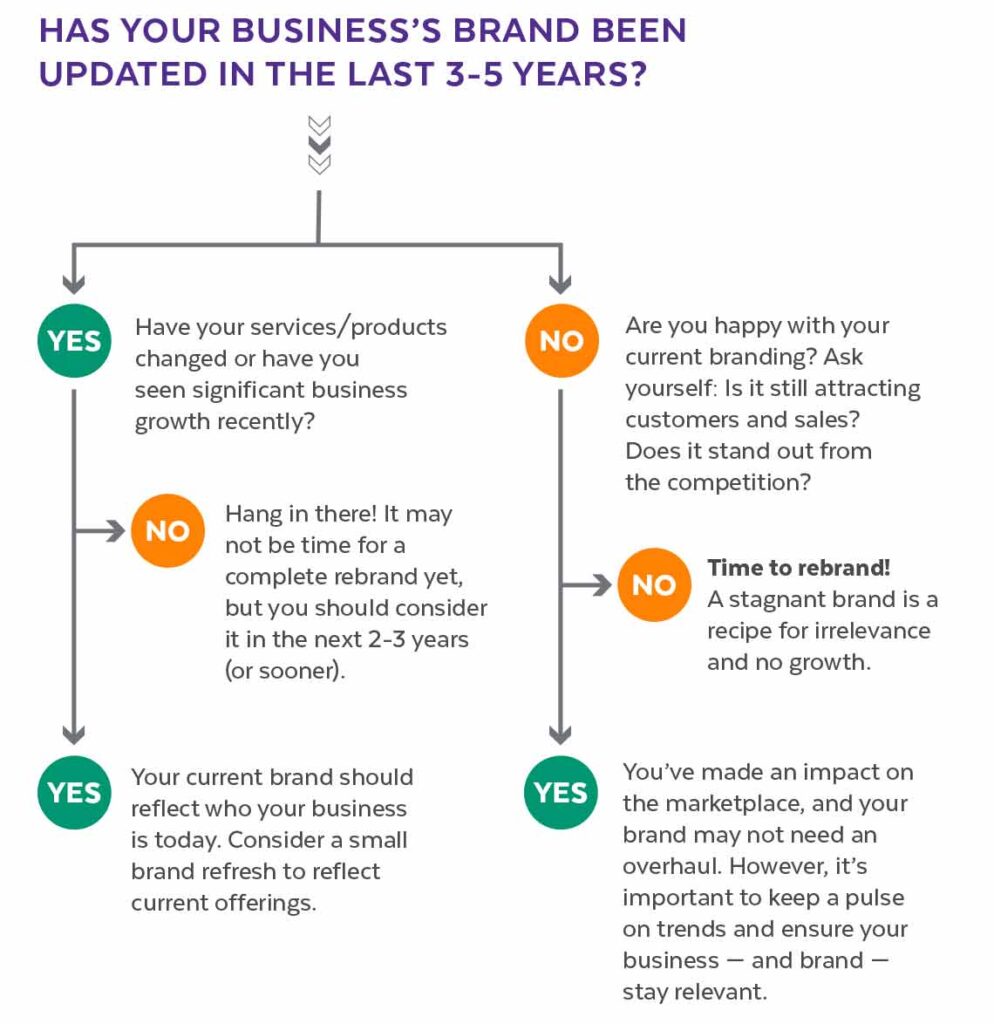Rebranding your business is key to staying relevant
and top of mind.

Breathe new life into a look that’s run its course — and catch the attention of potential clients — with a strategic rebrand.

Rebranding your business is one of those things that can seem needlessly complicated — if necessary, at all. After all, you worked hard to craft your company’s look and messaging, and you’ve gained business along the way. Why mess with a good thing?
There are actually quite a few reasons a strategic rebrand can make sense.
Changing trends can make an existing brand identity feel outdated and out of touch, for instance, while updates within your company itself might mean it’s time to reassess the messaging surrounding your vision, mission and values.
Beyond that, sometimes rebranding your business can simply make your marketing efforts more interesting and help grab the attention of current and potential clients.
Teaming up with an experienced marketing agency like Design At Work can help you zero in on a rebranding strategy that more accurately tells your company’s story. We work to ensure your refreshed brand feels familiar to customers who already know and trust you, while also drawing the attention (in all the right ways) of potential customers.
How do you know it’s time to consider rebranding your business?
It isn’t all about timelines, though. Here are some other key factors that might indicate it’s time to go back to the rebrand drawing board.
- Your brand no longer conveys who your company is. As they say, with time comes change. If you’ve added new products or services since establishing your brand identity, undergone a leadership change that sends your efforts in a new direction or even decided to pivot to a different target audience, there’s a good chance your existing branding no longer hits the mark.
- Your company wishes to distance itself from past negativity. Not all press is good press. If your business’s reputation has struggled due to undesirable PR, known issues related to the quality of your products or services, or even association with employees or vendors who have sullied pasts, a rebrand can serve as a fresh start that drives new business.
- You look too much like the competition. Imitation might be the highest form of flattery, but it can wreak havoc on your ability to make a profit. If your marketing efforts make it difficult for potential clients to distinguish your company from others out there, there’s a decent chance you’re losing out on business.
- Your brand identity has begun to feel stale. Even strong brands reach a point where they simply look a bit old. Maybe it’s due to a color palette that’s no longer on trend, or imagery your current and potential clients have seen so frequently that they become blind to it. Whatever the reason, a brand that’s begun to feel boring is no longer serving your company as it should.
Remember, because you see your company’s branding far more than any current or potential client will, you’re likely to become “bored” with it long before they do. Our marketing experts recommend seeking advice from a knowledgeable and objective third party to help determine whether the timing is right for an updated rebranding strategy.
Where do you even begin with a rebrand?

Once your company’s brand identity has reached that three- to five-year mark, it’s time to come together with your marketing agency for a bit of brainstorming. At this stage of the game, it’s all about determining what’s working with your existing brand, what (if anything) isn’t — and the smartest path forward.
If you do determine rebranding your business is the logical next step, you’ll want to work closely with your marketing firm to ensure you’re going about things in the smartest, most strategic manner possible.

Steps to Take When
Rebranding Your
Business.
At Design At Work, although every rebranding strategy is as unique as the company being rebranded, there are some general steps that tend to come into play.
- Take an objective look at the overall brand. This initial stage is all about determining how far you want to take your rebrand. Is it enough to simply rethink your approach to headlines and accent colors, or is it time for an all-out overhaul? Sometimes even subtle changes can make a world of difference.
- Think through how those changes will play out. So, you have an idea of WHAT you want to have happen. Now it’s time to decide HOW. We recommend updating your website with your new look and feel before any brand (or rebrand) rollout, since most all marketing materials will direct potential clients back that way. But, where else is your branding prominently featured?
- Announce your new look loud and proud. Rebranding your business is a big (big) undertaking. Once you’ve put in all that sweat equity, you’ll want to make that work known! Now’s the time to send email blasts or announcements out to existing customers — complete with your new look — letting them know you might appear a bit fancier now, but you’re still the company they’ve known and trusted for ages.
- Keep up the good work. The launch of your rebrand is just the start of things. From that point on, it’s all about remaining top of mind. Work closely with your marketing agency to develop a brand strategy that drives engagement, brings in referrals and keeps your company growing. That might include monthly email blasts, regular social media posts, advertisements and even website banner refreshes.
Still intimidated by the thought of rebranding your business? Rest assured lots of big-name companies have done so successfully. Among the more notable, you’ll find LEGO, Dunkin’ (formerly Dunkin’ Donuts) and Old Spice.
Ready to Refresh Your
Company’s Brand?
Our marketing experts are ready to help.


